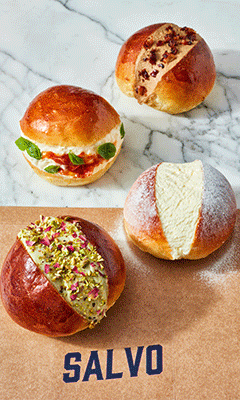Italopunk: 145 Recipes to Shock Your Nonna
by Vanja van der Leeden
Italian classics receive a cheeky update in Dutch-Indonesian chef and cookbook author Vanja van der Leeden's English-language debut, Italopunk: 145 Recipes to Shock Your Nonna. This collection of recipes, photos, and profiles takes readers to the Italy the author loves: vibrant, creative, and a bit rough around the edges. Classic flavor combinations and techniques are prized, but van der Leeden successfully makes the case that if people love their cuisine, they ought to let it grow.
While not Italian by birth, Vanja van der Leeden spent years living and cooking in Italy and developed a deep love of the country she first visited as a child. It's this love that drove her to create Italopunk, a book dedicated to reinventing, or at least updating, much-loved trattoria foods. Take her cacio e pepe con fave e menta, prepared with fava beans and mint. "Cacio e pepe is a Roman classic. The preparation shows how simple yet ingenious Italian cuisine is."
This appreciation is combined with a bit of historical context as the author describes her updated dishes. She observes that the red, green, and white caprese was invented in the 1920s "when the Italians were feeling particularly patriotic"; she roasts the tomatoes and adds a pop of flavor with fennel-chili breadcrumbs. Van der Leeden doesn't mince words when pushing back against ideas she feels are holding the food culture back. When introducing her "blasphemous" carbonara, which she says is "the pasta that conservative Italians are very theatrical and purist about while many hardly seem to know the history of the dish," she explains its origin. Then she suggests adding a shot of vodka.
With her husband, photographer Remko Kraaijeveld, van der Leeden establishes the less tourist-centric appeal of several Italian locales: Florence, Milan, Naples, Rome, Sicily, Turin, and Bologna. Photos of food are set alongside street art, everyday architecture and activities, market sights, and objects. A gorgeous Italian vista, a fish monger at work, and a mural of a busty mermaid companionably share the pages.
Van der Leeden's dishes remain the focus, however. Lovingly scuffed countertops, vintage dinnerware, and messy fingers make for a decidedly earthy presentation and make every dish a visual delight. Approachable, conversational recipes are organized by course and include a quick primer on making and cooking pasta. For readers outside Italy, the author helpfully includes substitutions and suggestions for sourcing high-quality, fresh ingredients.
Italopunk is a plant-forward book, lighter on meat and fish, in line with the author's approach to ethical, climate, and cost concerns. Meat cuts and preparations are selected to use as much of the animal as possible, and recipes include ingredients such as oxtail and veal tongue. Meat lovers will be more than happy to cook a version of the meatballs that U2's lead singer Bono savors, adapted for home cooks. Here, meat and fish aren't presented alone, but as composed dishes, such as the porchetta with lentil salad and roasted beets. Produce isn't relegated to the role of side dish, it's essential. Try dishes like Mezze maniche con ragù di cipolle (pasta with onion ragù and parsley breadcrumbs), which the author says is just as good as pasta Genovese, which relies on beef for richness.
Italopunk intentionally is not focused entirely on van der Leeden. In addition to citing her inspiration for many of these recipes, she features several "Italian chefs who dare to break free from the conservative corner in the country itself, to take Italian cuisine into the future without compromising the soul of that fine folk cuisine." These profiles tie together the gorgeous, eclectic photos and mouthwatering recipes and give the book a depth and character that keep it from feeling like food tourism.
In a deviation from the classic rice balls filled with seasoned meat, the author fills her arancini with eggplant, pistachio pesto, or shrimp ragù. She introduces readers to this recipe and to Sicilian food traditions with a profile of chef Emilia Strazzanti, whose Sicilian Arab heritage and years spent in London and Paris have informed how and what she cooks. Roman chef Sarah Cicolini is "combative and serious, always looking to improve, constantly open to innovation, and cooks her balls off." These chefs are innovative, but they also call upon generations of culinary and agricultural tradition as they strive to use all parts of an animal, carefully source ingredients, and work to retain a sustainable food system in the face of the changing Italian climate. In Milan, "offal activist" Diego Rossi, who cooks modern trattoria food informed by culinary traditions, says, "Tradition means history. To understand where we come from, we have to know that history, that's the only way you can face the future."
Readers who crave Italian food will find much to love in Italopunk, with plenty of inspiration for the creatives and instruction for those not quite ready to break all the rules. Fans of Yotam Ottolenghi, Samin Nosrat, and books like Pasta, Pane, Vino will want to pick this up. --Suzanne Krohn









